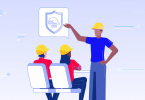Educational technology tools have enabled multiple channels of collaboration within the online learning environment. However, these tools are futile if the course facilitator or trainer doesn’t know how to use them or even ignores their existence!
In this article, we’ll share the top three forms of collaboration activities for your eLearning course that have proven to enhance eLearning experiences.
Effective Collaboration Activities: Types and Ideas
eLearning strategies, specifically the ones regarding collaboration, seem to increase every week, so we need to narrow them down and identify the ones that are proven to improve learning achievement and performance. Training experts highly encourage the use of the following collaboration activities – methods:
· Small group assignments
· Online field trips
· Group work on case studies
· Simulations
· Shared facilitations
· Homework forums
· Asynchronous discussion of the assigned reading
· Blogs or online journals that allow learners to reflect and comment on each other’s reflection
· Jigsaw activities where learners solve components of a large project in groups, and then bring their work together to form the whole project.
· WebQuests, where teams are sent out for online scavenger hunts to find the solution to a problem.
3 Top And Proven Collaboration Activities
Best practices indicate three forms of collaboration activities that lead to richer, and more effective, eLearning environments.
1. Learner Website/ePortfolio
An ePortfolio can be a very helpful weapon in your learners’ arsenal, and can be used for other courses as a form of a collaboration hub.
Require learners to visit at least five ePortfolios of their peers and comment on their work in the commenting area. Communicating and discussing professional skills under ePortfolios is a great way to break the ice in the online learning environment. It also enables learners to realize their worth and potential, as well as the gaps in their professional skills.
A good ePortfolio is evidence of learning and performance that takes years to complete. A good start is the development of a website that contains the following webpages:
a. About me: On this page, learners share their images, videos or other forms of identity they are comfortable with – including an avatar. Learners talk about themselves. They explain their current professional status and their aspirations for the future.
b. Skills and Projects: This page can have links to projects and samples of technical skills (for example, Photoshop projects etc.) that the learner has completed over the years.
c. CV: On this page, the learner uploads their CV to give their readers a complete idea of their background.
d. Reflections: Here, learners can write down their observations on their performance and their lessons learned.
2. Location Based Games – Augmented Learning
This form of learning is one of the most exciting, according to learners. Trainers usually think that augmented learning is hard to implement but, nowadays, there are several tools available to create games that are based on a historical or geographical backdrop.
It is similar to geocaching, except these games are linked to course objectives and based in a location where everyone can participate physically. Performance can be improved significantly if a location-based game is developed for the work context of the learners. After solving all problems presented in the location, guided by the game played on the learners’ smartphones, learners receive a score that determines the quality of their performance. For example, check out this great Game of Thrones eLearning game.
While these games are very interesting to implement, they are indeed time-consuming to create. Perhaps the best feature of these games is the degree of customization achieved for a learning situation. Games like these involve all learners and require participation for achieving points. Learners are regularly in touch with each other through the game’s social media.
3. Discussion forums
This is one of the oldest, yet still the favorite form of online collaboration activities. The course mentor posts different topics to observe the level and quality of learning demonstrated by participants. The success of this form of collaboration depends mostly on the course mentor. The goal is to categorize the questions according to the course learning objectives. Any negativity needs to be addressed and weeded out at an early stage.
A point awarding strategy is also versatile in discussion board activity – a way to motivate all learners to participate and provide their input. Experts tell us that we reveal more about ourselves through text as compared to speaking.
Discussion forums activities not only encourage collaboration, but they also provide a venting outlet for learners while they receive multiple feedback from their peers.
Wrapping up
Give these tips a shot next time you plan an eLearning course. Not only do these strategies encourage a strong social presence, but they also promote recognition of talent and skills. Collaboration is all about frequent and regular contact with peers to obtain the updates on a project or a task. Try integrating these three strategies in your next eLearning course and enjoy a better social interaction with your learners.




